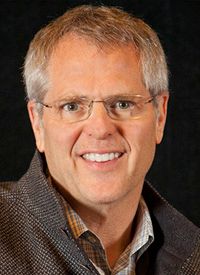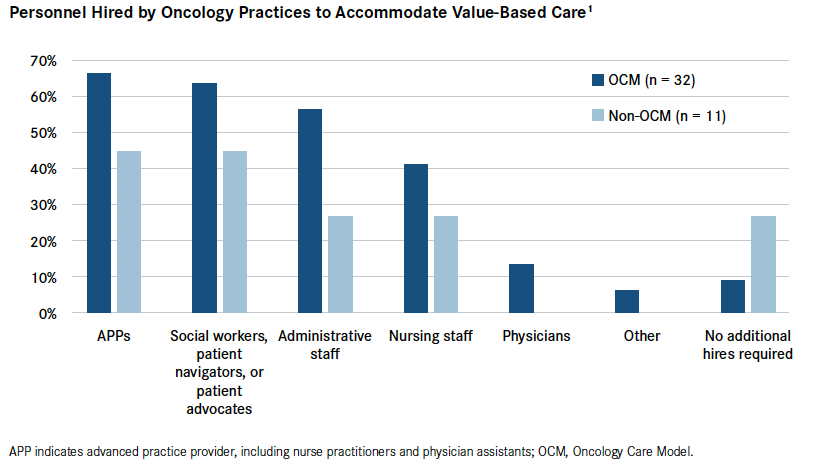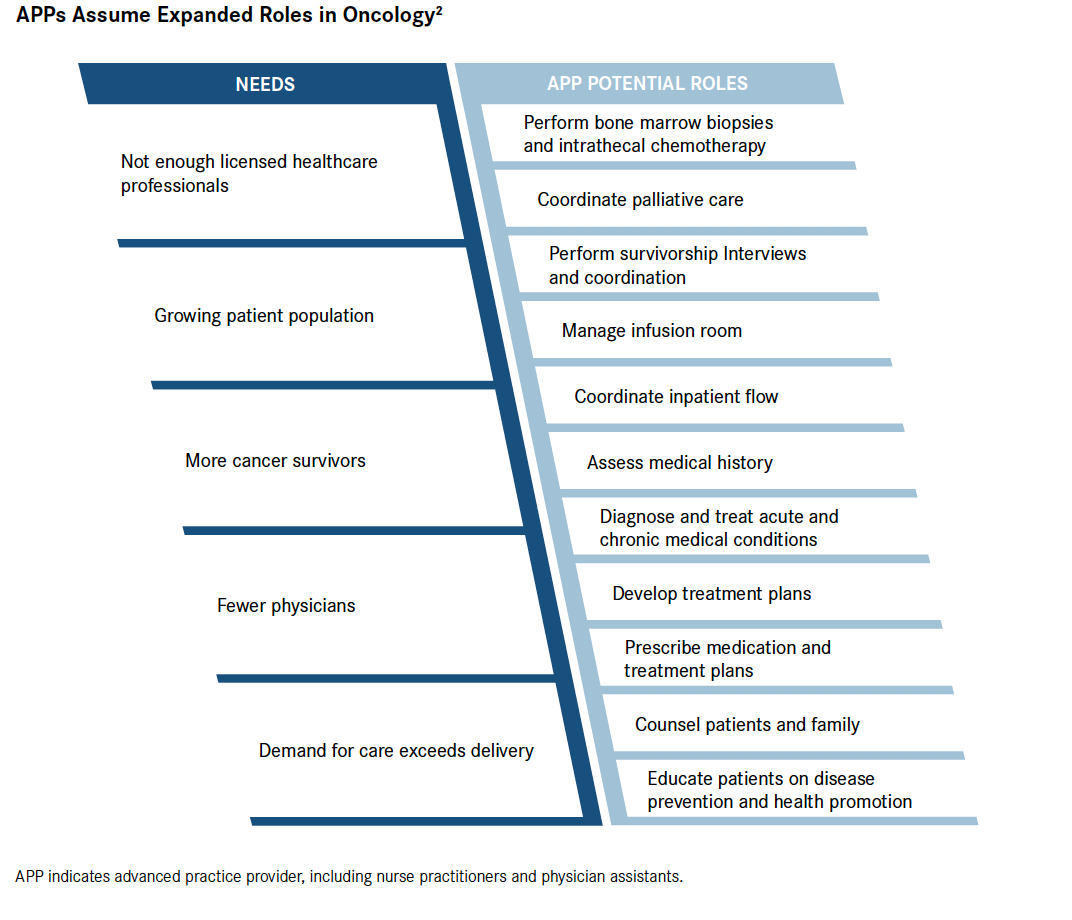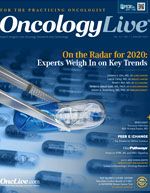Advanced Practitioners Improve Oncology Care Value
The aging of the baby boomer population and the growing number of cancer survivors have created a huge demand for oncology treatment services. Centers for Medicare & Medicaid Services has compounded the need by ratcheting up standards for value-based care. To handle these additional needs, many oncology practices now turn to advanced practice providers, typically nurse practitioners or physician assistants, who are highly trained and capable of taking over many of the routine functions of the oncology clinic.
Bruce A. Feinberg, DO

Bruce A. Feinberg, DO
The aging of the baby boomer population— those born in the 2 decades after World War II—and the growing number of cancer survivors have created a huge demand for oncology treatment services. Centers for Medicare & Medicaid Services (CMS) has compounded the need by ratcheting up standards for value-based care. To handle these additional needs, many oncology practices now turn to advanced practice providers (APPs), typically nurse practitioners or physician assistants, who are highly trained and capable of taking over many of the routine functions of the oncology clinic.
The results of a recent survey of oncologists participating in the Oncology Care Model (OCM) (n = 32) showed that 66% said their practices had employed APPs to help with case management, survivorship plan formulation, and many other aspects of care. Among non-OCM oncologists included in the same survey (n = 11), 45% said their practices had hired APPs (Figure 1).1
A sign that APPs may be helping bridge the gap is the absence of a commensurate increase in the hiring of oncologists. Among practices participating in the OCM, 56% hired more administrative staff, but only 13% hired more physicians, according to Bruce A. Feinberg, DO, a study coauthor and vice president and chief medical officer of Cardinal Health Specialty Solutions in Dublin, Ohio.
Many experts believe that APPs can improve productivity, revenue flow, and quality of care. They are assigned a broad range of tasks, and experts interviewed for this article said that a chief error made by practices is not employing APPs at the highest level that their license allows.
APPs are frequently used in patient education initiatives. They order imaging and laboratory studies, make supportive care decisions, discuss laboratory reports and end-of-life care with physicians, perform bone marrow biopsies, administer intrathecal chemotherapy, modify dosing, and select new therapies for patients (Figure 2).2 APPs may also provide interventions to lower the number of unnecessary emergency department (ED) visits.
These examples illustrate the diversity of APPs’ contributions to oncology practices. It is important to identify opportunities to do more with APPs, said Jason Astrin, PA-C, MBA, director of Advanced Practice Provider Services at McKesson in The Woodlands, Texas. APPs often serve merely as medical scribes for physicians during patient visits, although this tendency is changing. Over the past few years, APPs have increasingly been allowed to see patients independently, Astrin said.
Allowing APPs to see patients—the “independent model”—enables physicians to concentrate on higher-level care, which improves revenue flow and provides for greater job satisfaction for both APPs and physicians. Under this arrangement, overall quality of care also has the potential to improve. Physicians remain involved throughout and are available for consultation.
Figure 1. Personnel Hired by Oncology Practices to Accommodate Value-Based Care1 (Click to Enlarge)

When Federico Sanchez, MD, a hematologist and oncologist at Aurora Health Care of Milwaukee, Wisconsin, was on leave for knee surgery, his APPs managed his patient care. Aurora Health Care provides oncology services in 16 hospitals and 22 clinics across a 10-county area and has roughly 40 APPs supporting its oncologists amid rising demand for services.
At Aurora, the APPs share the outpatient care caseload with Sanchez and his physician colleagues. Patients alternate between seeing a physician and an APP. Sanchez continues to review all scans and tumor marker results, sees patients to discuss those results, and determines their therapy plans. When his services are not needed, the APPs can step in. “We’re looking to the APPs for maintenance visits,” he said.
Allowing APPs to operate at the top of their license means letting them practice to the full extent of education and training, rather than having them do things that less-skilled staff can do. When doctors are making hospital rounds, APPs can add value during these lower-volume office hours by doing in-office studies or procedures.
The important thing is to avoid redundancy, Feinberg said. “If the physician is going to see every patient the APP sees [at the same visit], there’s a question of how that is helping your bottom line.”
Some new and existing practice tasks might be better done by APPs. When Feinberg was practicing at Georgia Cancer Specialists in Atlanta, the APPs took over bone marrow biopsies, he said.
At Sanchez’s practice, APPs not only do bone marrow biopsies but also diagnose anemia cases, and they have reduced blood use by 25% in the oncology service. Coagulation consults, which are time consuming and less satisfying for physicians, are now done by APPs, Sanchez said.
At the Taussig Cancer Institute at Cleveland Clinic in Cleveland, Ohio, clinic operations are structured in a similar way, said Heather Koniarczyk, MSN, APRN-CNP, AOCNP, who manages advanced practice registered nurses and physician assistants at that facility.
Unnecessary Ed Visits
Figure 2. (Click to Enlarge)

Because CMS now requires information about chemotherapy-related ED visits and hospital admissions, Aurora recently appointed an APP in the oncology infusion suite to triage patients for urgent care. Patients phone or come in for APP-led interventions. “Most ED visits are between 8 am and 5 pm. By having an APP available to triage patients, we’ve reduced [ED] visits by 45%, and admissions are down by 35%,” Sanchez said.
Advance Planning is Key
Practices that are considering hiring an APP should also begin contemplating what the APP will do once hired. In the OCM, APPs are typically employed in care coordination, survivorship planning, and hospitalization and ED-use reduction.
However, practices tend not to hire until they are busy and pressed for time, which means that the onboarding and training processes may be weak, Astrin said. He encourages practices to do strategic planning and evaluate patient volume trends and physician needs in advance. If oncologists in a practice expect to reduce their workload or cease hospital work in 5 to 10 years, planning ahead is even more important.
Advance planning is critical in markets where APPs are in short supply. Training and onboarding should take place well before physicians begin to decrease their workload. Sanchez said that Aurora reviews patient volumes each month at operational meetings and considers APP hiring needs every 6 months.
However, most practices fail to do adequate research and planning before they hire APPs, Feinberg said. Ideal preparation involves considering how APPs will be used and which patients, physicians, and clinic locations they will support. Without careful placement, adding an APP can create chaos and division in the practice, he said.
APP Independence
Practices should predetermine the degree of autonomy the APP will have and whether the APP will support the entire clinic or specific physicians. The full scope of service should be defined in as much detail as possible, such as whether the APP will independently select or change antiemetics or modify chemotherapy due to toxicity.
Aurora has 1 APP for every 2 to 3 physicians, and the APPs are not necessarily paired with particular physicians. APPs are given job descriptions, and their duties are clearly specified. Their patient assignments may vary depending on changing volumes; APPs may see individual patients regularly or be matched with them on a rotating basis. In other practices, an APP working directly with a physician might consistently see the same patients.
Source of APP Pay
The practice must decide whether the APP’s salary will come out of the physician’s salary or from the practice itself. Practices should anticipate that APPs will not have an immediate positive impact on practice revenue. “There’s going to be a potential income loss, at least in the initial period, until the individual carries their own weight,” Feinberg said.
Training
To provide the greatest value, APPs should be assimilated into the practice culture and trained appropriately. Proper education can optimize the contribution APPs make to practice efficiency. The level of investment made in APPs varies from practice to practice. The US Oncology Network offers training and general guidance for its affiliated practices. There are week-long boot camps for new hires and a playbook for practices to follow. About 60% of APP hires in The Network are new graduates with no background in oncology. The remainder either have oncology experience and are switching practices or are experienced APPs from other fields—typically primary care or cardiac care, Astrin said.
Proper training, onboarding, and support can reduce the level of turnover, which is costly to a practice. Failure to retain an APP can amount to a $200,000 loss, Astrin said, which may include costs of recruitment, in-house training, and credentialing.
Before hiring an APP, a practice should understand there is an upfront investment and that profit may be delayed. Astrin estimates that new APPs may not begin seeing patients and generating revenue until the second year of employment. New APPs may need 6 to 8 months of ongoing shadowing and precepting before they begin to see patients. Astrin compares this process to pairing a resident or fellow with a physician during training. Even if an APP does not carry a full load at first, the physician workload will be reduced, and the practice may benefit. However, it may be 2 years before an APP feels comfortable practicing independently, Astrin said.
Aurora typically hires experienced nurse practitioners with a hospital background, often without training in oncology, Sanchez said. They receive that training from Aurora. This may be complemented by hands-on training in procedures or other specialty areas. APPs’ specific roles are written down, and this helps them learn their duties more rapidly, Sanchez said. By the end of 3 months, APPs are fully functional. They receive starter roles and then are evaluated by the lead APP, who determines the appropriate work setting and general function for them.
APPs provide maximum value when they have been trained for multiple functions. At Cleveland Clinic, some hospital-based oncology APPs were recently cross-trained in a pilot project that was successful on a number of fronts. APPs were cross-trained in blood and marrow transplants and the treatment of leukemia and lymphoma. Forty percent of staff were cross-trained within 3 months, and reasons for reassignment included open positions (64%), vacations and meeting coverage (65%), sick time and off-call status (65%), and periods of high patient volume (24%). Over an 8-month period from 2018 to 2019, this saved more than $23,180 in overtime pay and extra pay for physicians.3
Findings from the project indicated that team morale had improved and there was no APP burnout. The investigators noted that APPs quickly adapted and noticed similarities among patients and workflows that facilitated the process. They enjoyed the contact with fellow oncology APPs with whom they had not previously interacted. There was no decrease in productivity or quality metrics, and there was no increase in the incidence of adverse events.
Prior to the cross-training, the nurse practitioners sometimes felt annoyed about staffing shortfalls within their individual units. Now that resources are shared more evenly as part of a consolidated staffing operation, that problem has disappeared. At Cleveland Clinic’s oncology unit, about 30% to 40% of APPs are cross-trained.
Nurse practitioners with at least 1 year of experience in oncology and a good work record are eligible for cross-training. “Fifty percent of what we do is hospital medicine. Just because a patient has cancer doesn’t mean they won’t have sepsis, heart issues, or drug side effects,” Koniarczyk said. Complications from various cancer treatments are similar, even if the cancer types are not. That makes cross-training easier. Nurses usually need only 2 training shifts before they feel comfortable working in the larger group. During the pilot, no safety or quality issues were documented.
Changing the model to make APPs independent practitioners can change how they are viewed as well. “We want them to be colleagues, not employees,” Sanchez said.
References
- Kish J, Yey T-C, Gajra A, Jeune-Smith Y, Feinberg B. Community oncologists’ perceptions three years after the Oncology Care Model. Presented at: 2019 ASCO Quality Care Symposium; September 6-7, 2019; San Diego, California. Abstract 113.
- Cairo J, Muzi MA, Ficke D, et al. Practice model for advanced practice providers in oncology. Am Soc Clin Oncol Educ Book. 2017;37:40-43. doi: 10.14694/EDBK_175577.
- Koniarczyk H, Tackitt H. Cross training of APPs on inpatient oncology units as a safe and cost-effective model. J Clin Oncol. 2019;37(suppl 27; abstr 56). doi: 10.1200/ JCO.2019.37.27_suppl.56.
Having APPs see patients has enabled some practices to double the number of patient visits while providing continuity of care in case of physician illness or absence, according to oncologists interviewed for this article.




